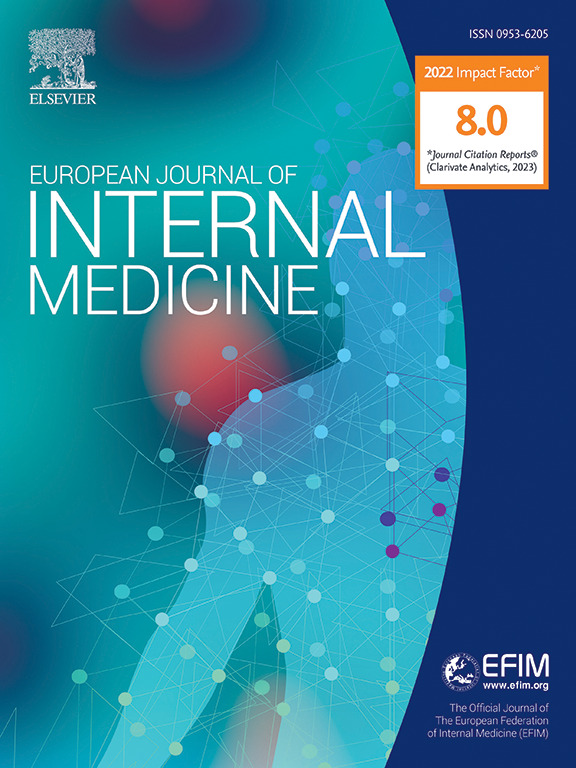潜在分类分析确定具有独特临床特征的新型乳糜泻亚群:一项多中心研究。
IF 6.1
2区 医学
Q1 MEDICINE, GENERAL & INTERNAL
引用次数: 0
摘要
背景:乳糜泻(CD)是一种终身免疫介导的疾病,其临床特征广泛,经常挑战传统的分类,如奥斯陆定义。我们的目标是利用潜在分类分析(LCA)识别基于临床特征的新型CD亚型,并通过预测监督模型验证这些表型。方法:在这项多中心回顾性研究中,分析了来自意大利19个中心(2011-2021年)的2478名成年CD患者。收集临床、实验室、内镜和组织学资料。将LCA应用于分类症状变量,包括胃肠道、血液学、神经精神表现和疲劳,以识别潜在的群集,并通过贝叶斯信息准则确定最佳类别数。使用卡方检验将新衍生的类别与传统的Oslo分类进行比较,同时使用多项逻辑回归(MLR)验证潜在类别与附加特征之间的关联。结果:LCA鉴定出4个类别,即1类(以下消化道症状为主);2级(上消化道表现);第三类(主要是无症状或非特异性病例);第4类(小细胞贫血伴虚弱)。与奥斯陆分类的比较显示部分重叠,表明在现行标准下可能存在分类错误。MLR证实了显著相关性,女性与2级密切相关(OR 2.7, 95% CI 1.52-4.78)。自身免疫合共病(OR 1.96, 95% CI 1.18-3.25)和严重的组织学损伤(B2 Corazza-Villanacci分类,OR 9.12, 95% CI 1.86-44.63)在2级患者中也更为常见。结论:LCA可能提供一种新的、数据驱动的方法来完善CD表型,这应该在未来的研究中得到验证。本文章由计算机程序翻译,如有差异,请以英文原文为准。
Latent class analysis identifies novel coeliac disease subgroups with distinctive clinical features: a multicentric study
Background
Coeliac disease (CD) is a lifelong, immune-mediated disorder characterised by a wide clinical spectrum, which often challenges traditional classifications like the Oslo definitions. We aimed to recognise novel CD subtypes based on clinical features using latent class analysis (LCA) and validate these phenotypes with a predictive supervised model.
Methods
In this multicentric retrospective study, 2478 adult CD patients from 19 Italian centres (2011–2021) were analysed. Clinical, laboratory, endoscopic, and histological data were collected. LCA was applied to categorical symptom variables, including gastrointestinal, haematological, neuropsychiatric manifestations, and fatigue, to identify latent clusters, with the optimal number of classes determined by the Bayesian Information Criterion. The newly derived classes were compared with the traditional Oslo classification using Chi-squared tests, while multinomial logistic regression (MLR) was employed to validate the associations between latent classes and additional features.
Results
LCA identified four classes, namely Class 1 (predominant lower gastrointestinal symptoms); Class 2 (upper gastrointestinal manifestations); Class 3 (mainly asymptomatic or nonspecific cases); and Class 4 (microcytic anaemia with asthenia). Comparison with the Oslo classification revealed partial overlap, indicating potential misclassification under current criteria. MLR confirmed significant associations, with female sex strongly linked to Class 2 (OR 2.7, 95 % CI 1.52–4.78). Autoimmune comorbidities (OR 1.96, 95 % CI 1.18–3.25) and severe histological damage (B2 Corazza-Villanacci classification, OR 9.12, 95 % CI 1.86–44.63) were also more frequent in Class 2.
Conclusions
LCA may offer a novel, data-driven approach to refine CD phenotyping that should be validated in future studies.
求助全文
通过发布文献求助,成功后即可免费获取论文全文。
去求助
来源期刊
CiteScore
9.60
自引率
6.20%
发文量
364
审稿时长
20 days
期刊介绍:
The European Journal of Internal Medicine serves as the official journal of the European Federation of Internal Medicine and is the primary scientific reference for European academic and non-academic internists. It is dedicated to advancing science and practice in internal medicine across Europe. The journal publishes original articles, editorials, reviews, internal medicine flashcards, and other relevant information in the field. Both translational medicine and clinical studies are emphasized. EJIM aspires to be a leading platform for excellent clinical studies, with a focus on enhancing the quality of healthcare in European hospitals.

 求助内容:
求助内容: 应助结果提醒方式:
应助结果提醒方式:


